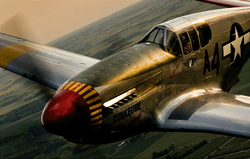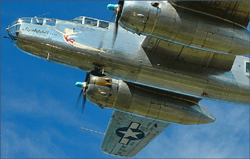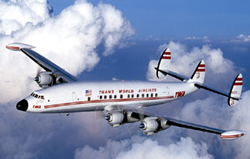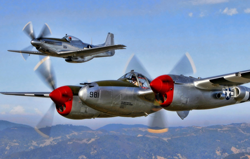Lightning

Manufacturer: Lockheed Corporation
Primary Role: Heavy Fifghter
- Description:
- Specifications:
The P-38 Lightning fighters were uniquely designed by Clarence "Kelly" Johnson's design team, the "Skunk Works", at Lockheed as a response to the 1937 United States Army Air Corps request for an interceptor. The prototype flew on 27 Jan 1939 with its distinctive twin booms. By Feb the prototype was already a record setter, flying across the United States from California to New York in only 7 hours and 2 minutes; the design's speed remain unmatched until the arrival of jet aircraft. Although the record setting trans-continental flight ended in a crash landing, the US Army Air Force, renamed from the USAAC, placed an order for 66 fighters. The first batch of production Lightnings came off of the production line in Sep 1940 with some design differences from the prototype; they were lighter in weight and the propellers were rotating in the opposite directions (both now spin away from the cockpit). In Jun 1940, after taking over only three Lightnings, Britain canceled her order of over 800 Lightning fighters due to less than expected maneuverability; those fighters already produced for the canceled order went to the United States Army Air Force for training purposes. In mid-1941, the USAAF took delivery of the first 66 fighters; some of them included self-sealing fuel tanks and one was equipped with an experimental pressurized cabin. The main purpose of this batch was not for front-line combat, but rather to work out the potential kinks in the design. For instance, American pilots found tail flutter to be a problem, and it was promptly fixed by Johnson and his engineers. Compressibility stall, a deadly problem that could occur when this high performance fighter reached high altitudes, was also discovered though would not be resolved until later. One problem that was discovered but never addressed was that the cockpit became cold in freezing conditions. In Oct 1941, the first combat-ready P-38 Lightning fighters rolled off of production lines, and by Jun 1942 they were seeing combat in the Aleutian Islands, where their endurance won great acclaims by their pilots. While they also served in Europe and North Africa, their long range made them ideally suited for the Pacific War (plus cold weather conditions that froze pilots did not exist in South and Central Pacific). Pilots Richard I. Bong and Thomas J. McGuire were both awarded the Medal of Honor for their performances while flying these fighters. Saburo Sakai, the famed Japanese fighter ace, commented after the war that the P-38 Lightning fighters "destroyed the morale of the Zero fighter pilot." A number of Lightnings were produced as reconnaissance aircraft, night fighters, and two-seat versions to include a radar operator on the aircraft. Production of the Lightnings lasted until the very end of the; by then, over 10,000 were made.
Length: 11.53 m
Height: 3.90 m
Powerplant: Two Allison V-1710 liquid-cooled V12 engines rated at 1,150h
Cruising Speed: n/a
Maximum Speed: 667 km/h



